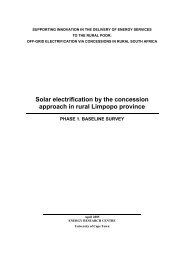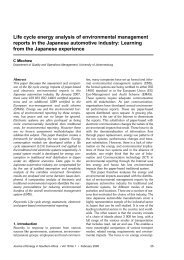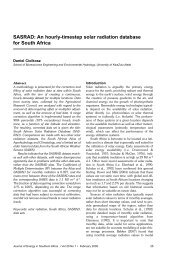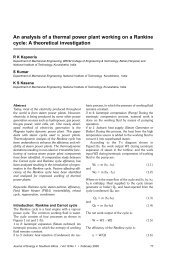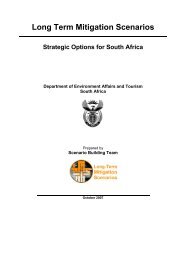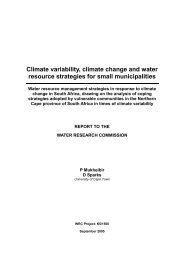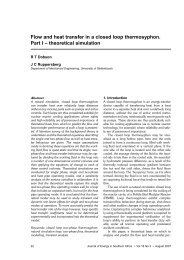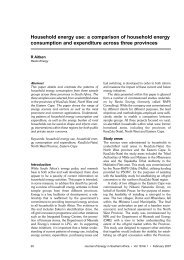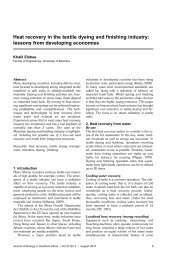Stainless steel finned tube heat exchanger design for waste ... - erc
Stainless steel finned tube heat exchanger design for waste ... - erc
Stainless steel finned tube heat exchanger design for waste ... - erc
You also want an ePaper? Increase the reach of your titles
YUMPU automatically turns print PDFs into web optimized ePapers that Google loves.
series of steps and becomes negative between thermocouples<br />
8 and 9.<br />
This was hypothesised that this anomalous<br />
behaviour could be explained by the distribution of<br />
hot exhaust gas flowing through the <strong>heat</strong> <strong>exchanger</strong>.<br />
Figure 5 shows the expected exhaust flow. As the<br />
exhaust gas enters the ducting, it rises to the top half<br />
of the ducting, creating turbulent vortices in the bottom<br />
half.<br />
These turbulent vortices will result in a better<br />
<strong>heat</strong> transfer through the bottom and sides of the<br />
ducting, cooling the exhaust down and exposing the<br />
lower parts of rows 3, 4 and 5 to a lower temperature;<br />
the end result being the actual cooling of the<br />
liquid-vapour mixture inside the <strong>finned</strong> <strong>tube</strong>s. This<br />
hypothesis was tested using convection theory.<br />
and T av is in Kelvin.<br />
The Reynolds number is determined by<br />
and the Rayleigh number by<br />
Ra = Gr.Re (27)<br />
By using a range of values <strong>for</strong> T surf between 25<br />
and 340°C along with Mills (1995), the results show<br />
that mixed convection conditions occur inside the<br />
ducting. This would result in a secondary motion<br />
where the exhaust gas would flow upwards along<br />
the wall and downwards in the central region <strong>for</strong>ming<br />
a vortex which would increase the <strong>heat</strong> transfer<br />
and result in a lower exhaust temperature. A way of<br />
eliminating this would be to ensure the equal distribution<br />
of the hot exhaust gas through the ducting<br />
with the help of guide vanes. In addition, Van Zyl et<br />
al (2006) also conducted a CFD simulation of the<br />
gas flow inside the ducting. Some generic results<br />
from that research are shown in Figure 6 and typically<br />
indicate flow separation and re-circulation of<br />
the gas occurring.<br />
Another interesting phenomenon shown by<br />
Figure 4 is the fact that the inlet gradient between<br />
thermocouples 1 and 4 is much steeper than predicted<br />
by the simulation program. The explanation<br />
<strong>for</strong> this phenomenon has a connection to the<br />
exhaust extraction fan which was situated at the<br />
outlet of the exhaust ducting. In experimental testing,<br />
a change in the <strong>heat</strong> transfer coefficient was<br />
noted when the fan was switched on, while no<br />
notable change was measured in the air mass flow<br />
rate at the continuous combustion unit.<br />
The flow meter restricts air flow when set to a<br />
certain volumetric flow rate, while the exhaust fan<br />
increases the suction at the outlet of the ducting.<br />
The result is a low pressure zone which <strong>for</strong>ms<br />
between the <strong>heat</strong> <strong>exchanger</strong> and the exhaust fan<br />
prompting the acceleration of the gas and giving a<br />
higher <strong>heat</strong> transfer coefficient within the <strong>heat</strong><br />
<strong>exchanger</strong>. This was confirmed by the experimental<br />
measurements as the simulated pressure drops<br />
(approximately 1 Pa) was much lower than the<br />
actual pressure drop (approximately 8-10 Pa)<br />
across the <strong>heat</strong> <strong>exchanger</strong>.<br />
Figure 7 (the use of different inlet conditions)<br />
shows similar temperature behaviour, as described<br />
in Figure 4. From Figure 7, it is evident that test runs<br />
5 and 9 as well as test runs 8 and 10 follow the<br />
same temperature path <strong>for</strong> the last half of the <strong>heat</strong><br />
<strong>exchanger</strong>, despite the fact that they have different<br />
starting gradients.<br />
Figure 6: (left) A sectional temperature distribution through a diffuser<br />
(right) A sectional velocity field through a diffuser<br />
52 Journal of Energy in Southern Africa • Vol 17 No 2 • May 2006




